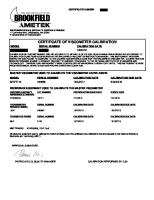SASM Sample [PDF]
Sample Test: SAFe® Advanced Scrum Master This sample test provides example (not actual) content and format of the questi
48 2 388KB
Papiere empfehlen
![SASM Sample [PDF]](https://vdoc.tips/img/200x200/sasm-sample.jpg)
- Author / Uploaded
- Muralidhar
Datei wird geladen, bitte warten...
Zitiervorschau
Sample Test: SAFe® Advanced Scrum Master This sample test provides example (not actual) content and format of the questions that will be on the certification exam. Performance on the sample test is NOT an indicator of performance on the certification exam and this should not be considered an assessment tool.
1. What is a key role of the scrum master? A. To accept Stories B. To estimate Stories C. To manage the team D. To help the team identify and remove bottlenecks 2. What is an example of an anti-pattern a scrum master might face? A. Teams coordinate with other teams. B. Developers do not work collaboratively on stories. C. Teams that keep stories small to support team iteration. D. A product owner representing the “Voice of the Customer”. 3. Who acts as the “Chief Scrum Master” for the ART? A. Scrum Master B. Business Owner C. Product Manager D. Release Train Engineer 4. What is the recommended timeframe for cadence-based PI planning? A. 4-6 weeks B. 6-8 weeks C. 8-12 weeks D. 12-16 weeks 5. During PI planning, what are two key purposes of the hourly scrum of scrums checkpoint meeting? (Choose two.) A. To help keep teams on track. B. To support early identification of risk. C. To align milestones with PI objectives. D. To keep stretch objectives within scope. E. To ensure PI objectives have direct user value. 6. What is the purpose of the solution demo? A. To inspect and adapt. B. To identify work that is not completed. C. To plan for future cadence-based planning. D. To compare planned vs. actual business value.
7. What benefit does cadence development provide? A. Limits WIP B. Limits variability C. Synchronization D. Causes multiple events to occur at the same time 8. What is a typical measurement in Kanban? A. Velocity B. Code quality C. Average WIP D. Queue length 9. What is one of the most important tasks of a scrum master? A. Increasing the velocity B. Fostering collaboration C. Following Scrum ceremonies D. Reporting status to management 10. What are two actions a team can take to improve economic outcomes? (Choose two.) A. Late integration B. Increase velocity C. Test automation D. Research spike/enabler E. Delay performance testing
Answer Key: 1. D 2. B 3. D 4. C 5. AB 6. D 7. B 8. C 9. B 10. CD
(End of sample test)









